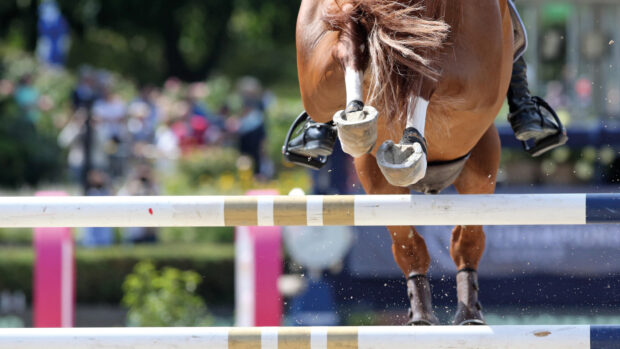Horses in lush green fields may incorrectly be considered to have a higher body condition score than if they were in a bare paddock – and vice versa – owing to our eyes playing tricks on us.
In a study published in the Equine Veterinary Journal, researchers from the University of Liverpool and the British Horse Society (BHS) aimed to understand whether grass cover of the background environment in which a horse is viewed can influence perception in body condition scoring.
Photographs of 20 horses were taken in their usual fields, then superimposed on a background image of sparse grass and a background of lush grass. More than 150 participants – owners, vets, vet nurses and students and other equestrian professionals – assessed the images and scored the horses’ condition.

A picture of a horse superimposed on a background of sparse grass.
“The analysis of data showed that the body condition scores given to horses was significantly higher on the lush pasture than the bare pasture, for both mean and median values,” the researchers concluded.
“Overall, the findings of this research project highlight that background environment has an impact on the visual perception of body condition scoring in horses.”
Lead author Holly Hibberd, a vet student at the University of Liverpool and a rider, told H&H it is important that owners consider their horses’ environment when considering their weight.
“We believe it is to do with visual perception, and it would be interesting to see if this is the case with other species too. The idea is that if they are on a lush pasture, they look like they have more food and it almost tricks your brain into thinking they must be on the bigger side. Whereas if they’re on a pasture with less food, you might think, ‘They must be starving,’ so think they look smaller,” she said.
“We need to be aware that when they’re on different types of pasture, there might be some form of bias. It’s really important that we manage our horses’ weight and we don’t want anything to skew how we look at them.”
Miss Hibberd said future research in this area might look at the differences in body scores when a horse is on a yard or under saddle, to see how scores compare between more environments.
She added that body condition scoring is “very useful” to owners.
“Not everyone has access to a weighbridge, so going off how your horse looks and knowing what a good body condition score looks like is really important. There are lots of websites, including the BHS, that provide guides on how to score body condition.”
A BHS spokesperson told H&H that the society recommends keeping a picture diary of horses’ weight, using the same neutral background for all photos.
“While it is also helpful to keep the environment in mind when looking at our horses, it is vital to do hands-on scoring regularly,” she said.
“We therefore strongly encourage horse owners and carers to continue to use their hands to feel for, and take note of, areas of fat across the horse’s body. It is the best way to capture an accurate score, which is extremely important in order to keep our horses at a healthy weight.”
Read the study abstract
- To stay up to date with all the breaking news throughout Blenheim Horse Trials, Horse of the Year Show, London International and more, subscribe to the Horse & Hound website
You may also be interested in:

Obesity concerns in horses as study finds weight tapes underestimate true values

10 top tips for finding and retaining employees
We look at advice and tips from some of the speakers on how to be a good employer and how

Subscribe to Horse & Hound magazine today – and enjoy unlimited website access all year round





